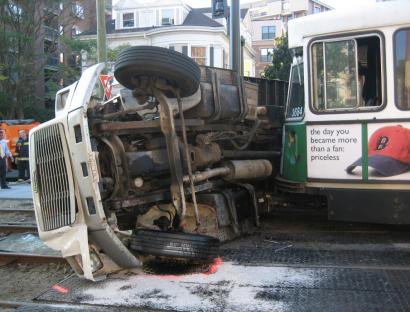citylover94
Senior Member
- Joined
- Oct 27, 2012
- Messages
- 1,140
- Reaction score
- 58
Forget EMU's LRT is really the only option that is truly viable from what F-Line has said in the past.
The TL;DR I'm getting is: no DMU and/or conventional push-pull. Full stop. Thanks for reiterating.
You wouldn't need to TBM Eastie Haul Road. The ancestral ROW was in a 4-track cut after crossing the river because it fed a freight yard under the footprint of Route 1A. When the freight started dying out and the old retaining walls in the cut needed repair, they simply backfilled the unneeded width with earthen embankments and buried the old retaining walls. The Haul Road only uses a fraction of the old space, so all you need to do is: scoop out the rest of the embankment back to the original ROW width, pour new retaining walls framing the restored cut, and shift the haul road pavement from centered to along the walls. Then there's plenty of space on the opposite wall for a grade-separated 2-track rail ROW. That's exactly how the Urban Ring plans it for any rail mode. Won't be that expensive, because the Haul Road isn't that long to begin with.Okay, so what about EMU, LRT, or BRT with TBM under the Eastie Haul Road? I'm familiar with Alon's argument about direct airport connectors, but TBM under airport to effectively allow LRT or EMU-ification/circumvention of Silver Line sounds like it'd be feasible if:
How exactly do you propose to have a commuter rail line running through an active busway, an active haul road, a well-used public park, a gigantic highway interchange, and a hotel?
Grade crossings: RR always has priority, leaving no chance of timing the signal cycles at Broadway for traffic management. Car queues will have to be dumped retroactively after a train passes, not proactively or proportionally.
You keep saying the crossing has to be on a fixed cycle. I'm not buying it that if a segment of track were designated as non-mainline track that it couldn't be put in by special instruction that the trains must follow a traffic signal.

It does. It absolutely does. You can't cherry-pick your own definition of "mainline" / "not-mainline" on a train schedule that shares track on with real no-foolin' mainline trains on a single seat.
Seriously...it's becoming the definition of insanity to keep going down this wormhole time and again in pursuit of a proof-of-concept when we already have a proposed project with open either/or choice of modes that empirically does all of its stated job at none of the downsides of mainline rail and all the mission creep cost required to make mainline rail only moderately shitty transit instead of irredeemably shitty transit. What am I missing here that keeps bringing us back to this crack-cocaine of intensity of belief in the empirically inferior mode least-suited to task?
Have express train service from various points outside of the city. Example, from Quincy Adams to South Station. The line would have its own dedicated tracks, make zero stops in between, and run at 55-60 mph. You could add spokes at the Braintree Logan Express stop, Westwood/128, another at the 95/90 interchange in Weston, another up in Burlington.
Except... that is exactly what is done at North Station, Reading, and Lowell -- albeit not for a crossing.
Plop a station sign east of Mass Ave (call it MIT), west of Mass Ave (call it Cambridgeport), designate MIT to Cambridgeport as Rule 98 Other-Than-Main-Track and add a special instruction to obey the traffic signals. Gates will not operate unless the circuit is occupied.
Here's an idea - we decide as a region that we can and must make room for faster more frequent transit service because that serves the public more sensibly, take away highway width (talk far enough in the future and we'll need to do that anyway otherwise we just have 2x more lanes of autonomous vehicles using the same road width, not really helping reverse the auto-centric commuting trends that have major externalities).
There - more ROW for high capacity regional rail network.
Dedicated express tracks? How?
This is crazy transit pitches, so you add them in. Really every other town along the 128 belt should have high speed transit service right into Boston. Non-stop and fast. It especially should be in use along the Southeast Expressway to help alleviate stress. We're never going to get that stretch widened and brought up to modern standards, so why not make transit options better to provide a solid alternative for people who otherwise drive?
The only good thing about the red line going into Boston from Braintree and Quincy Adams is the fact that it runs frequently. Beyond that, the ride takes far too long.
actual workable proposals or solutions or at least potentially workable, but are projects that are not on the radar or are incredibly unlikely to be built.
